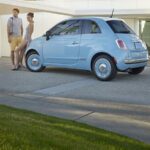As the growth of battery-electric vehicle (BEV) sales plateaus in many markets, the automotive industry is actively seeking innovative strategies to accelerate the shift to electric mobility. Alongside plug-in hybrid electric vehicles (PHEVs), extended-range electric vehicles (EREVs), often referred to as Long Range Evs, are gaining renewed attention as a potential solution. These long range EVs aim to alleviate range anxiety and address cost concerns that still deter many owners of traditional internal combustion engine (ICE), hybrid, and even existing electric vehicles from fully embracing all-electric cars.
Understanding Long Range EVs: Bridging the Gap
Many prospective electric vehicle buyers are hesitant to pay the higher price tag often associated with BEVs compared to equivalent ICE vehicles. Beyond cost, driving range consistently ranks as a major concern for car buyers. This “range anxiety” is particularly pronounced for individuals living in apartments or homes without convenient overnight charging access, and for those who frequently undertake longer journeys where public charging infrastructure may be perceived as inadequate. While the average daily commute is typically under 50 miles, a significant portion of drivers require vehicles capable of much greater distances without refueling or recharging.
Long Range EVs vs. PHEVs: What’s the Difference?
A long range EV, or extended-range electric vehicle (EREV), represents a unique blend of battery-electric and internal combustion engine technologies. While plug-in hybrid electric vehicles (PHEVs) typically utilize a parallel powertrain configuration where both an electric motor and an ICE can directly power the wheels, EREVs employ a series configuration. In this series setup, the ICE functions solely as a generator, producing electricity to recharge the battery pack and extend the driving range. This is a crucial distinction in how long range EVs operate compared to PHEVs.
Conventional PHEVs are equipped with smaller battery packs than both BEVs and EREVs. In a typical PHEV, the ICE engine engages to provide mechanical drive either when the battery is depleted or when the driver demands additional power while in electric mode. PHEVs generally offer an electric driving range of 20 to 40 miles, after which they operate as traditional ICE vehicles.
Both long range EVs and PHEVs offer the convenience of charging at standard EV charging stations, home chargers, and fast-charging outlets, and their ICE components can be refueled at conventional gas stations. However, as the name “extended-range” suggests, long range EVs are engineered to deliver significantly greater electric driving ranges, typically between 100 and 200 miles.
Image alt text: Powertrain comparison diagram showing that long range EVs use a series hybrid system where the gas engine only charges the battery, unlike PHEVs which use a parallel hybrid system to directly power the wheels.
The inherent ability of long range EVs to mitigate range anxiety, coupled with their strong sales performance in markets like China, has captured the attention of automotive manufacturers (OEMs) in Europe and the United States. These manufacturers are exploring long range EVs as a viable pathway to stimulate EV sales growth. While EREVs were present in the initial wave of electrification a decade ago, they did not gain widespread traction, as early EV adopters were primarily focused on pure BEVs. However, the EV market is evolving beyond early adopters to encompass mainstream car buyers who seek a more diverse range of options. Long range EVs, distinct from PHEVs, combine a small ICE generator with an electric powertrain, offering a substantial electric-only range of 100 to 200 miles (compared to 20 to 40 miles for PHEVs) and a total combined range of 400 to 500 miles.
Drawing upon industry analysis and recent surveys of car buyers in the US and Europe, this article investigates the potential of long range EVs to attract a broader customer base to electric driving, potentially exceeding the appeal of BEVs or PHEVs alone. It also considers the strategic implications for OEMs contemplating investments in this powertrain technology amidst tight budgets and increasingly stringent regulatory deadlines.
Consumer Appeal of Long Range EVs: Education is Key
Recent surveys of new car buyers in the United States, Germany, and the United Kingdom reveal a significant segment that would consider a long range EV for their next vehicle purchase if available. Importantly, a substantial two-thirds of these potential buyers indicated they would otherwise opt for an ICE or hybrid vehicle if long range EVs were not an option. This suggests that long range EVs have the potential to convert ICE vehicle owners to electric driving who might not otherwise make the switch.
Image alt text: Bar chart showing survey data that indicates the introduction of long range EV options increases buyer preference for EVs and reduces preference for ICE and PHEV vehicles across Germany, UK, and US markets.
The primary reason cited by consumers for preferring ICE vehicles over EVs, after price, is “range anxiety.” This encompasses concerns about limited driving distance compared to ICE vehicles, the perceived scarcity of convenient fast-charging stations compared to gas stations, the need for frequent recharging, and the fear of running out of power before reaching a charging point.
Interestingly, interest in long range EVs was more pronounced among owners of premium-brand vehicles compared to mass-market brands. Furthermore, owners of larger vehicles and SUVs showed slightly greater interest in long range EVs than those owning smaller cars.
A critical market segment for long range EVs could be current EV owners considering reverting to ICE vehicles due to frustrations with charging infrastructure limitations and range constraints. Surveys have shown that a considerable percentage of current EV owners are contemplating switching back to ICE vehicles, highlighting a potential opportunity for long range EVs to retain these customers within the electric vehicle ecosystem.
Despite the apparent appeal of long range EVs to various buyer segments, effective consumer education is crucial. It is essential to clearly communicate the benefits of long range EVs and demystify the distinctions between EREVs, PHEVs, BEVs, and other hybrid vehicle types. Consumer confusion, particularly in the United States, regarding the different EV and hybrid powertrains is significant. A large percentage of US car buyers express feeling overwhelmed by the current variety of powertrain options available.
Limited but Growing Availability of Long Range EVs
Currently, the global market offers a limited selection of long range EVs. However, this is beginning to change. In the United States, long range EV models are emerging, particularly in the SUV and truck categories. Examples include the Ram 1500 Ramcharger, boasting a 145-mile electric range and a 690-mile total range. In China, manufacturers like Li Auto have launched several successful long range EVs, such as the L9, which offers a 134-mile electric range and an impressive 817-mile total range. AITO’s M9 further demonstrates the potential, with an electric range of 140 to 170 miles and a total range of 840 to 871 miles. VW-backed Scout Motors has also announced long range EV models that have reportedly garnered significant pre-orders, exceeding those for their BEV counterparts.
A 100- to 200-mile electric range is generally sufficient to cover the daily commuting needs of most drivers, while a total range of 350 to 600 miles effectively addresses range anxiety for longer trips. This range combination appears to represent a potential “sweet spot” for the long range EV market.
Image alt text: Chart showing a sweet spot for long range EVs with 100-200 miles electric range and 300-700 miles total range, positioned between PHEVs with shorter electric range and BEVs with longer electric but sometimes limited total range.
Favorable Regulatory Landscape in the United States
Looking ahead, the United States market presents particularly promising opportunities for long range EV sales. While the European Union is progressing towards zero-emission vehicle mandates by 2035, the regulatory environment in the US is currently more favorable to long range EVs.
The EU’s zero-emissions vehicle target effectively limits the sale of new ICE vehicles, including EREVs, after 2034. OEMs operating in the EU must carefully evaluate the limited timeframe and development timelines to determine if the potential market demand for long range EVs justifies the investment. It’s worth noting that EREV powertrains may offer a more future-proof strategy for OEMs compared to PHEVs, as they are built upon a BEV platform with a small, range-extending generator rather than a drivetrain-integrated ICE.
In contrast to the EU, the United States does not have a federal mandate for zero-emission new car sales. Instead, the US Environmental Protection Agency (EPA) emission standards provide compliance bonuses tied to electric driving ranges. This incentivizes longer electric ranges, potentially giving long range EVs an advantage over PHEVs. For example, an EREV with a 70-mile or greater electric range could receive a substantial compliance bonus, while a PHEV with a shorter 25-mile range would receive a smaller bonus. California’s Advanced Clean Cars II rule, while aiming for 100% electrification by 2035, allows for up to 20% of new car sales to be PHEVs or EREVs, granting full credit for vehicles with electric ranges of at least 70 miles.
Therefore, from a regulatory perspective, the United States appears to be the most advantageous market for the growth of long range EVs.
Cost Competitiveness of Long Range EVs
Long range EVs have the potential to be a cost-competitive alternative to both BEVs and ICE vehicles. By focusing on an electric range of around 150 miles, the combined powertrain costs of an EREV could be significantly lower than those of a comparable BEV. While the cost gap between BEV and EREV production is expected to narrow as battery costs decline, EREVs are projected to maintain a cost position between BEVs and ICE vehicles. In a modeled scenario, an EREV pickup truck with a 150-mile electric range and a 500-mile total range could utilize a smaller battery pack than a BEV requiring a much larger battery to achieve the same total range. This difference in battery size translates to potentially substantial powertrain cost savings for EREVs.
Image alt text: Chart comparing production costs, showing that long range EVs currently have lower production costs than BEVs, although this difference may reduce as battery prices fall.
If OEMs can capitalize on these potential production cost advantages and price long range EVs attractively to both ICE-vehicle loyalists and BEV-hesitant buyers, long range EVs could be instrumental in revitalizing EV sales growth. However, OEMs must carefully weigh the decision to invest in EREV platforms, considering the added complexity to their vehicle portfolios. To justify the development costs, significant sales volumes are necessary.
Long range EVs can serve as a crucial bridge technology, facilitating the transition from ICE vehicles to BEVs. They offer a compelling option for consumers who are not yet ready to fully commit to BEVs, while charging infrastructure continues to improve and BEVs become more mainstream and cost-competitive. For car buyers apprehensive about EVs, long range EVs present a welcoming alternative, provided manufacturers can make the technology accessible and effectively differentiate EREVs from PHEVs, other hybrid vehicles, and BEVs, especially within the US market. For OEMs to successfully leverage long range EV technology, rapid time-to-market is paramount, along with meticulous planning and management of development costs and more intricate supply chains and production processes.

